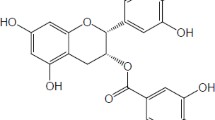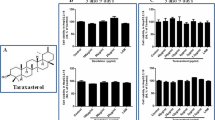Summary
In this study, the anti-HBV effects of tea polyphenols (TP) were examined. After cells were exposed to TP for 3, 6, 9 days, amounts of HBsAg, HBeAg and HBV-DNA released into the supernatant of the cultured HepG2 2.2.15 cells were detected. TP, to some extent, inhibited the secretion of HBsAg and strongly suppressed the secretion of HBeAg in a dose-dependent (P<0.01) and time-dependent manner, with 50% maximal inhibitory concentration (IC50) value being 7.34 μg/mL on the 9th day, but the time-dependence was not significant (P=0.051). Expression of HBV-DNA in the supernatant of the cell culture also was significantly decreased in a dose-dependent fashion (P<0.01). The IC50 of TP in inhibiting HBV DNA was 2.54 μg/mL. It concluded that TP possessed potential anti-HBV effects and may be used as a treatment alternative for HBV infection.
Similar content being viewed by others
References
World Health Organization. Hepatitis B fact sheet WHO/204. Geneva: World Health Organization, October 2000. [Accessed February 10, 2006, http://www.who.int/mediacentre/factsheets/fs204/en
Chisari FV. Rous-Whipple Award Lecture. Viruses, immunity, and cancer: lessons from hepatitis B. Am J Pathol, 2000, 156(4):1117–1132
Merle P, Trepo C. Therapeutic management of hepatitis B-related cirrhosis. J Virol Hepatitis, 2001, 8(6):391–399
Benhamou Y, Bochet M, Thibault V, et al. Safety and efficacy of adefovir dipivoxil in patents co-infected with HIV and lamivudine-resistant hepatitis B virus: an open label pilot study. Lancet, 2001, 358(9283):718–723
Manesis EK, Hadziyannis SJ. Interferon α treatment and retreatment of hepatitis be antigen-negative chronic hepatitis B. Gastroenterology, 2001, 121(1):101–109
Kwon DH, Kwon HY, Kim HJ et al. Inhibition of hepatitis B virus by an aqueous extract of Agrimonia eupatoria L. Phytother Res, 2005, 19(4):355–358
Yang CS, Lambert JD, Hou Z, et al. Molecular targets for the cancer preventive activity of tea polyphenols. Mol Carcinog, 2006, 45(6):431–435
Kawai K, Tsuno NH, Kitayama J, et al. Epigallocatechin gallate, the main component of tea polyphenol, binds to CD4 and interferes with gp120 binding. J Allergy Clin Immunol, 2003, 112(5):951–957
Katiyar SK. UV-induced immune suppression and photo-carcinogenesis: chemoprevention by dietary botanical agents. Cancer Lett, 2007, 255(1):1–11
Lambert JD, Hong J, Yang GY, et al. Inhibition of carcinogenesis by polyphenols: evidence from laboratory investigations. Am J Clin Nutr, 2005, 81(1):S284–S291
Chen H, Zhang M, Qu Z, et al. Compositional analysis and preliminary toxicological evaluation of a tea polysaccharide conjugate. J Agric Food Chem, 2007, 55(6):2256–2260
Sells MA, Chen ML, Acs G et al. Production of hepatitis B virus particles in Hep G2 cells transfected with cloned hepatitis B virus. Proc Natl Acad Sci USA, 1987, 84(4):1005–1009
Block TM, Lu X, Platt FM, et al. Secretion of human hepatitis B virus is inhibited by the imino sugar N-butyldeoxynojirimycin. Proc Natl Acad Sci USA, 1994, 91(6):2235–2239
Chang JS, Liu HW, Wang KC, et al. Ethanol extract of olygonum cuspidatum inhibits hepatitis B virus in a stable HBV-producing cell line. Antiviral Res, 2005, 66(1):29–34
Carmichael J, DeGraff WG, Gazdar AF, et al. Evaluation of a tetrazolium-based semiautomated colorimetric assay: assessment of chemosensitivity testing. Cancer Res, 1987, 47(4):5875–5879
Li CQ, Zhu YT, Zhang FX, et al. Anti-HBV effect of liposome-encapsulated matrine in vitro and in vivo. World J Gastroenterol, 2005, 11(3):426–428
Lok AS. The Maze of Treatments for Hepatitis B. N Engl J Med, 2005, 352(26):2743–2746
Seef LB, Lindsay KL, Bacon BR, et al. Complementary and alternative medicine in chronic liver disease. Hepatology, 2001, 34(3):595–603
Dhiman RK, Chawla YK. Herbal medicines for liver diseases. Dig Dis Sci, 2005, 50(10):1807–1812
Yang CS, Landau JM, Huang MT, et al. Inhibition of carcinogenesis by dietary polyphenolic compounds. Annu Rev Nutr, 2001, 21:381–406
Mukhtar H, Ahmad N. Tea polyphenols: prevention of cancer and optimizing health. Am J Clin Nutr, 2000, 71(6 Suppl):1698S–1702S
Garbisa S, Sartor L, Biggin S, et al. Tumor gelatinases and invasion inhibited by the green tea flavanol epigallocatechin-3-gallate. Cancer, 2001, 91(4):822–832
Suganuma M, Okabe S, Kai Y, et al. Synergistic effects of (−)-epigallocatechin gallate with (−)-epicatechin, sulindac, or tamoxifen on cancer-preventive activity in the human lung cancer cell line PC-9. Cancer Res, 1999, 59(1):44–47
Nakane H, Ono K. Differential inhibition of HIV-reverse transcriptase and various DNA and RNA polymerases by some catechin derivatives. Nucleic Acids Symp Ser, 1989, (21):115–116
Harada S, Haneda E, Maekawa T, et al. Casein kinase II (CK-II)-mediated stimulation of HIV-1 reverse transcriptase activity and characterization of selective inhibitors in vitro. Biol Pharm Bull, 1999, 22(10):1122–1126
Yamaguchi K, Honda M, Ikigai H, et al. Inhibitory effects of (−)-epigallocatechin gallate on the life cycle of human immunodeficiency virus type 1 (HIV-1). Antiviral Res, 2002, 53(1):19–34
Fassina G, Buffa A, Benelli R, et al. Polyphenolic antioxidant (−)-epigallocatechin-3-gallate from green tea as a candidate anti-HIV agent. AIDS, 2002, 16(6):939–941
Singh R, Ahmed S, Islam N, et al. Epigallocatechin-3-gallate inhibits interleukin-1beta-induced expression of nitric oxide synthase and production of nitric oxide in human chondrocytes: suppression of nuclear factor kappaB activation by degradation of the inhibitor of nuclear factor kappaB. Arthritis Rheum, 2002, 46(8):2079–2086
Kawai K, Tsuno NH, Kitayama J, et al. Epigallocatechin gallate induces apoptosis of monocytes. J Allergy Clin Immunol, 2005, 115(1):186–191
Kawai K, Tsuno NH, Kitayama J, et al. Epigallocatechin gallate attenuates adhesion and migration of CD8+ T cells by binding to CD11b. J Allergy Clin Immunol, 2004, 113(6):1211–1217
Chen JH, Tipoe GL, Liong EC, et al. Green tea polyphenols prevent toxin-induced hepatotoxicity in mice by down-regulating inducible nitric oxide-derived prooxidants. Am J Clin Nutr, 2004, 80(3):742–751
Zhen MC, Wang Q, Huang XH, et al. Green tea polyphenol epigallocatechin-3-gallate inhibits oxidative damage and preventive effects on carbon tetrachloride-induced hepatic fibrosis. J Nutr Biochem, 2007, 18(12):795–805
Higashi N, Kohjima M, Fukushima M, et al. Epigallocatechin-3-gallate, a green-tea polyphenol, suppresses Rho signaling in TWNT-4 human hepatic stellate cells. J Lab Clin Med, 2005, 145(6):316–322
Cooper R, Morre DJ, Morre DM, et al. Medicinal benefits of green tea. Part I. Review of noncancer health benefits (review). J Altern Complement Med, 2005, 11(3):521–528
Pugh JC, Bassendine MF. Molecular biology of hepadnavirus replication. Br Med Bull, 1990, 46(2):329–353
Lambert JD, Hong J, Yang GY, et al. Inhibition of carcinogenesis by polyphenols: evidence from laboratory investigations. Am J Clin Nutr, 2005, 81(1 Suppl):284S–291S
Author information
Authors and Affiliations
Additional information
The project was supported by a grant from the R&D Department of Hubei Province (No. 2007B07).
Rights and permissions
About this article
Cite this article
Ye, P., Zhang, S., Zhao, L. et al. Tea polyphenols exerts anti-hepatitis B virus effects in a stably HBV-transfected cell line. J. Huazhong Univ. Sci. Technol. [Med. Sci.] 29, 169–172 (2009). https://doi.org/10.1007/s11596-009-0206-1
Received:
Published:
Issue Date:
DOI: https://doi.org/10.1007/s11596-009-0206-1




